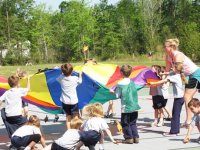Teaching Personal/Social Management Skills in Physical Education
Your content has been saved!
Go to My Saved Content.In physical education, curricular requirements such as fitness development, motor skills and health knowledge must be pursued with vigor. But after my 38 years in the field, let me state the obvious. All teachers, specialists included, should consider their subject matter as secondary to teaching children. This primary mission occurs when we prioritize two goals:
- Building a sound relationship between teacher and student
- Guiding the student in the study of personal/social management skills (PSMS)
When students acquire PSMS, they are more likely to succeed academically, in play and in work. In the following section, I outline some PSMS strategies.
Time and Teacher Health
Every day, specialists are faced with students coming and going for short periods. It can be a struggle to find time for:
- Catching a breath and reflecting during a lesson
- Building a relationship with students
- Writing some notes (see below)
- Privately guiding individuals towards self-reflection and PSMS development
Two ways to create opportunities to facilitate the above in a PE environment include Green Time and Fun Fabulous Friday (FFF).
Green Time (Free Choice)
After students enter the gym and change into their active clothes, give them 5-7 minutes to choose among many activities: badminton, rope skip, basketball, wall climb, etc. During this time, make specific notes about individuals in the previous class, and then review notes made yesterday in order to provide feedback that is sincere, personalized and helpful about incidents that occurred. The Green Time allows you to discuss problems with a less emotional mindset. The conversation consists of just acknowledging an issue and a specific suggestion about how to handle it going forward. All discussions must be held in a nonthreatening, inviting mode. Over days, weeks and years, such communication develops healthy relationships and specific PSMS.
For a student who plays too aggressively, alienating his or her peers, begin with inviting or leading questions in private, such as:
- "I called you in because I would like to help you with . . ."
- "How are you today? Yesterday, you might remember that there was a problem with . . ."
- "Have you thought of trying . . . ?"
Watching others at play with the aggressive student is an excellent modeling strategy or opportunity. "Do you see anyone who is having fun? What are they doing? How are they behaving? Would it be fun to play like that? Would you like to try playing like that? What would you have to do in order to play like that?" The student observes other players while considering the set of questions posed. Afterward, send him or her out to practice whatever surfaced during the discussion.
Fun Fabulous Friday (FFF)
Every two weeks, provide students with a multitude of activity choices that include everything an educator can bring into the teaching environment. These might include: climbing frame, table tennis, various active electronic devices, dance station, etc. FFF activities give you a more extended opportunity to continue the strategies noted above. More detailed PSMS development ensues. Some astute readers might imagine that students could take an affront at missing a chance to participate fully in FFF or Green Time. However, you need to spend only a short time with each student. When he or she returns to play, call another student over for a conference. As you develop a relationship with the student and he or she gains insights about how to interact more successfully, these conversations are enjoyable for both parties.
During FFFs, you have an opportunity to conduct a short roleplaying scenario either privately with the student or including another classmate. To promote tone awareness, give examples of how saying the same thing in different ways affects how one is received. After roleplaying, send the student out to participate in the FFF for a short time, and then call him or her back after a while to review how well the suggestions worked. This type of guided practice helps students absorb the lessons of PSMS development.
Students' PSMS development takes time and practice, as I discuss in my book, Teaching Elementary Physical Education in the Calm Zone. The teacher's notations about student behaviors are scientific and sometimes even bureaucratic, yet success comes only with detailed observation and a human touch.
